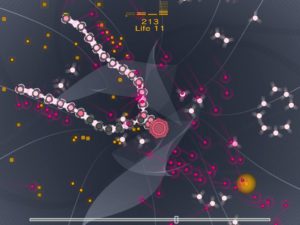Combat: End Boss
The level 30 boss turns out to be a sort of flying saucer deal, a big rotating octagon that rises up from a pit in the center of a large room, then sinks again. It alternates between doing two things when it rises: spawning a bunch of assorted tanks and autobombs, and firing those big sweeping lasers from four guns on its periphery — and reversing its direction of rotation while it’s firing them, to make things more difficult. You can destroy the lasers with a great deal of effort, and on one try I even managed to destroy two, but, interestingly, doing so is actually counterproductive. The same lasers destroy any enemy tanks they hit, so disabling them means more tanks hanging around through a complete cycle. You have a lot more to fear from the tanks than from the regular and predictable lasers, so the lasers are really your friends — just the sort of friend you don’t want to hug. And ultimately, all you really have to destroy is the saucer’s central dome, which is briefly level with your guns on its way up and down. The best way to deal with this whole thing, I found, was to basically ignore the tanks and just keep circle-strafing around the pit as fast as you can to make it hard for anything to hit you.
I had to play through this bit several times before I got it right, and every time I did so, I had to play the preceding nine levels first. As usual, I could only bring myself to play one session at a time, rather than start from level 21 again immediately, but being so close to finishing the game off made me keep coming back. You get good at the levels with a little practice; you start to remember the layouts and anticipate what you need to do, and so you rush about with efficiency and confidence. On my final attempt, I even got the Iron Man bonus on level 21 — a score bonus, of enough points for me to snag an extra life, for passing a level without getting hit even once.
Similarly, each pass at level 30 taught me a little more about how to go about it. In fact, only the very first time I reached level 30, with too few lives and no idea of what to expect, did I actually run out of lives and end the game there. On subsequent tries, I managed to slog through it with heavy losses, finishing the level and reaching the real end boss, which was a bit of surprise the first time it happened.
Your final foe is small and agile — well, still about twice the size of your own tank, but small for a boss. It’s hard to aim at, because it does the same thing I was doing on the previous level: circling around quickly, making it difficult to know how much to lead it with your aim, occasionally getting behind the camera so you don’t know which way to turn. It would probably still be a pretty easy fight, though, if it weren’t for one thing: the time limit. You have 60 seconds to beat it or lose. In effect, the game has given up trying to kill you. By getting this far, you’ve proved that you know how to play carefully and conserve your health, and so it throws a different limitation at you. Moreover, it’s a limitation that requires a more or less opposite approach. Where the correct approach for most bosses is caution, this one requires courage. You need to take it down as quickly as possible, and that means getting right up close to it and blasting it as much as you can, heedless of the damage it’s doing to you. Your biggest advantage over it is that you can only lose one hit point at a time, and go through a brief period of flashing invulnerability every time you do.
Combat got poor reviews when it came out, but, while it isn’t the best of the around-the-year-2000 classic-game remakes — that would be Frogger — I found it to be a fairly satisfying experience. It is, in a way, retro-futuristic. Usually that term means the sci-fi visions of the future from the 1950s or earlier, but what I mean here is that it’s the sort of videogame envisioned in 80s sci-fi, from Tron to Zot!. As such, it’s appropriate that it uses so many elements from 80s scrolling shooters: bosses with destructible weapons, power-ups that spread your fire in three directions, etc. Translating stuff like that into 3D was always a challenge, and Combat handles it better than a lot of games of the period — mainly by keeping the action mostly bound to a plane.
 Comments(0)
Comments(0)